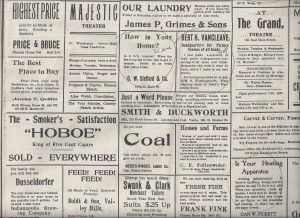In Blogging, the More Things Change……

On a recent tour of interesting Indiana places, I picked up the most fascinating souvenir – The Daily Review newspaper published February 19, 1908 in Crawfordsville.
Since my work at Say It For You centers around business marketing, I was particularly fascinated with Page 3 of the paper, which sported a crazy patchwork of advertisements. Needless to say, the prices of goods more than 110 years ago provided a source of entertainment: Men’s tailored suits were available for a cost ranging from $18 to $40, while two light brooms were advertised at 25 cents for the pair. Interested in real estate? 58 acres of good land, including a six-room house, a barn, a large orchard were going for $2,450.
Since a favorite topic of mine as a professional ghost blogger and business blogging trainer is commanding readers’ attention, even more interesting to me as I scanned the Daily Review were the different appeals advertisers used to grab readers’ attention:
Problem solving
“Is your heating apparatus working satisfactorily? If there is anything wrong, just telephone me and I’ll fix it in a jiffy,” claimed Dan Pickett. “If you have forgotten your laundry till Friday or Saturday, call on us. We make a specialty of time work,” James P. Grimes & Sons assured prospects. “Kill the cough and cure the lungs!” is the way Dr. King promoted his cough medicine.
Price reductions
“Our entire stock of furniture and stoves to be closed out in the next 30 days at prices unheard of before,” said Joel Block, while jeweler and optician Otto announced he would be selling 101 Masonic Temple souvenir spoons, normally priced at $1.75 and $2.25, for only $1.00 each.
Special expertise
“I make a specialty of high grade enlargements consisting of all sizes and finish. Remember this work is done by hand, which I make in my own studio,” claimed Bert Vancleave. “You get the benefit of our technical knowledge and of our persistently clear cut methods,” said corner jeweler J.A. Oswald.
Fear marketing
“How is your home?” asked O.W. Stafford & Co. “Is it fully insured? When the fire is started, it is too late to get it insured. Better let us write that policy today.”
Appeal to customers’ desire to be part of a trend
“Smoke a clay pipe. They are the thing in pipes just now.”
Back in 1908, to be sure, no one was blogging. Still, today, although blogs should be more like advertorials than advertisements, every one of these advertising approaches might be used in business blog writing to appeal to consumers.
You know what they say: The more things change, the more they remain the same!

 “Learn the lingo to beat the scammers,” advises
“Learn the lingo to beat the scammers,” advises 


Follow us online!